B1-series battle droids, also known as B1 battle droids or standard battle droids, were a type of battle droid that constituted the main fighting force of both the Trade Federation Droid Army and the Separatist Droid Army. Galactic Republic clone troopers often derisively called them "Clankers," and they served as the foundation for the more sophisticated OOM-series battle droid.
Perhaps the most abundant—and easily sacrificed—soldiers in the entirety of galactic history were the B1s. Unlike most biological soldiers, they could operate effectively in harsh environments like underwater or in the vacuum of space. Their primary design purpose was to overwhelm enemies with sheer numbers, rather than relying on advanced tactical thinking (making them susceptible to deception) or highly developed combat skills (unlike clone troopers).
The Trade Federation's military frequently utilized the B1 battle droid as a standard soldier. Consequently, B1s participated in almost every engagement involving the Trade Federation.
In the initial battles, these droids needed a central computer to process information and "think." However, this dependency was largely eliminated after the Battle of Naboo, when an attack destroyed the mainframe stationed there, causing all droids on the planet to become inactive.
B1 battle droids had a height of 1.93 meters and a humanoid body structure. Their design, featuring long, slender necks supporting elongated heads, was inspired by their creators at Baktoid's Geonosian foundries. Neimoidians, known for their superstitions, spread rumors that the heads of B1 battle droids were modeled after the appearance of a deceased, withered Neimoidian skull, which many species found unsettling. They were powered by rechargeable batteries, allowing for approximately two days of operation per charge.
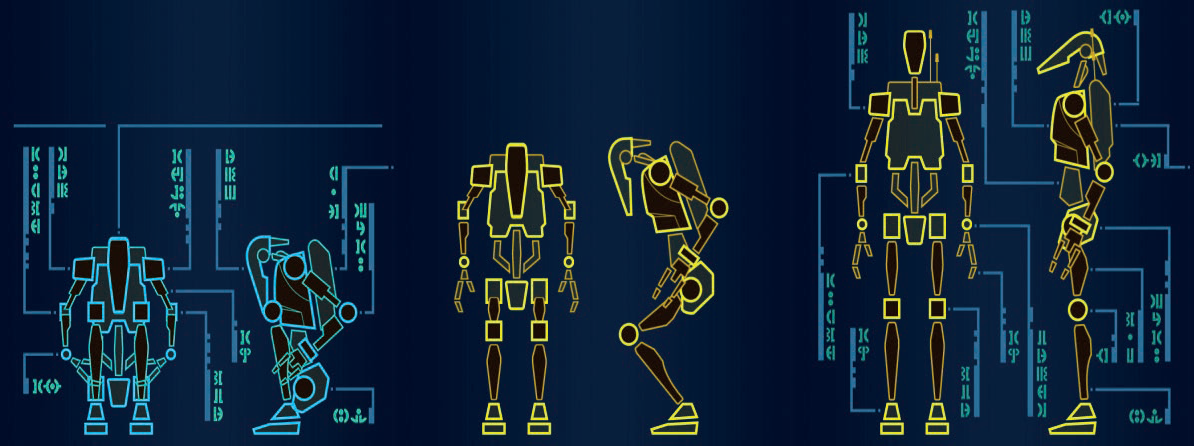
Certain B1 units, classified as the OOM-series, received enhanced programming and were distinguished by color-coding to indicate their specific roles, such as commander or security personnel. Some were painted in different colors to blend into a certain environment, such as the reddish-colored B1 droids manufactured on Geonosis. B1s typically operated under the control of a central mainframe located on a remote starship or another secure location. However, this reliance could lead to catastrophic failure if the central control mainframe was destroyed, as demonstrated during the Battle of Naboo, when Anakin Skywalker obliterated the Droid Control Ship. The significant defeat at Naboo sparked interest in autonomous battle droids, a concept that gained traction following the battle and throughout the Clone Wars.

The electromagnets responsible for holding their limbs together were prone to malfunctions. During the Clone Wars, Galactic Republic clone troopers discovered that targeting the hips, torsos, and arm joints of B1s was an effective way to quickly neutralize them. Nevertheless, a direct head shot remained the only certain method of disabling a droid. They didn't need arms, legs or even bodies to pass intel to central command.
B1s were intentionally designed for inexpensive mass production. Consequently, they were quite fragile and vulnerable, but they could overwhelm enemies by sheer weight of numbers. More advanced models, such as the droideka, B2 super battle droid, grapple droid, and B1-A air battle droid, were more costly and therefore less common, but they were also superior soldiers.
In combat, battle droids utilized E-5 blaster rifles, SE-14 blaster pistols, and thermal detonators. They communicated in a monotonous, high-pitched voice. The vocal characteristics varied among units around the time of the Battle of Naboo, but during the Clone Wars, their voices were uniformly altered to a higher pitch.
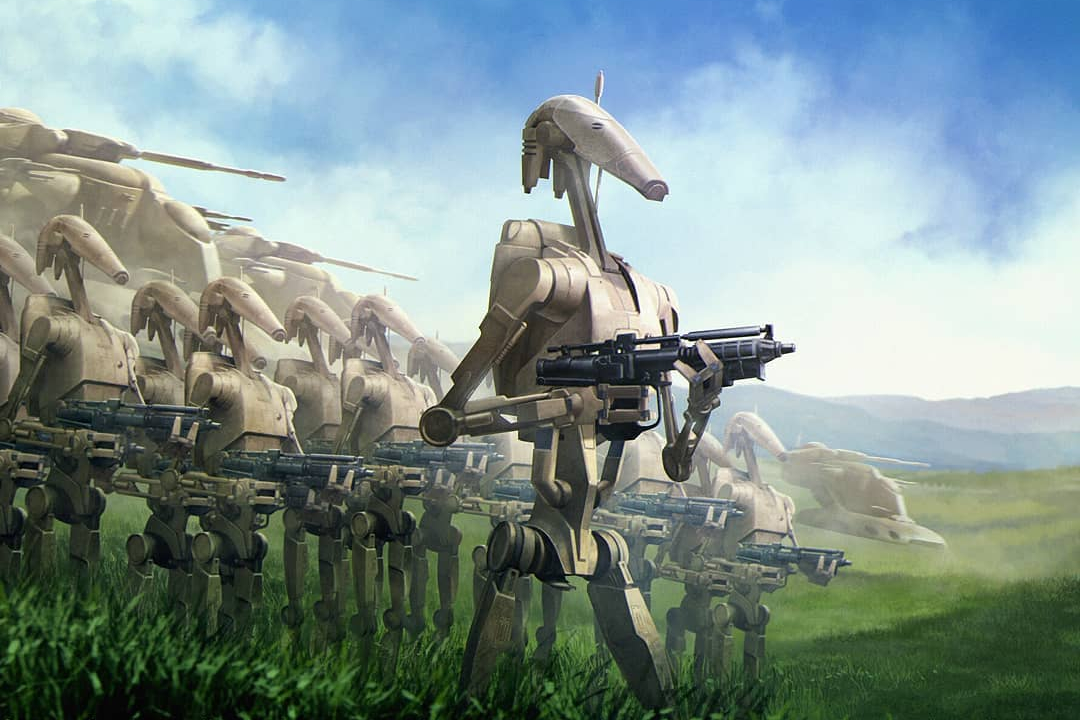
B1 droids typically employed basic combat tactics. They were deployed in massed parade formations or simple swarms and rarely demonstrated any understanding of cover. However, as the Clone Wars progressed, wartime developments led to some improvements in B1 programming. Despite these advancements, their reaction times in battle remained slow, and they exhibited minimal initiative. General Grievous, the commander of the droid army, held a strong dislike for battle droids due to their inferiority compared to the Republic's clone troopers.
Despite their apparent weakness, B1s were capable of defeating enemies in hand-to-hand combat, as demonstrated during the Battle of Grassy Plains, where battle droids successfully engaged Gungan soldiers in one-on-one engagements.
While earlier models depended entirely on Central Control Computers, post-Naboo versions were updated with cognitive modules that enabled independent thought, allowing for greater autonomy and personality. However, as they were assigned increasingly specialized roles that stretched their programming limits, many older droids developed quirks and a tendency to excessively comment on their situations in an attempt to manage the data overload that strained their inadequate logic modules.
A variety of governments and armed forces employed B1s. Even smugglers were known to use them, though in smaller quantities compared to the massive armies of the commerce guilds.
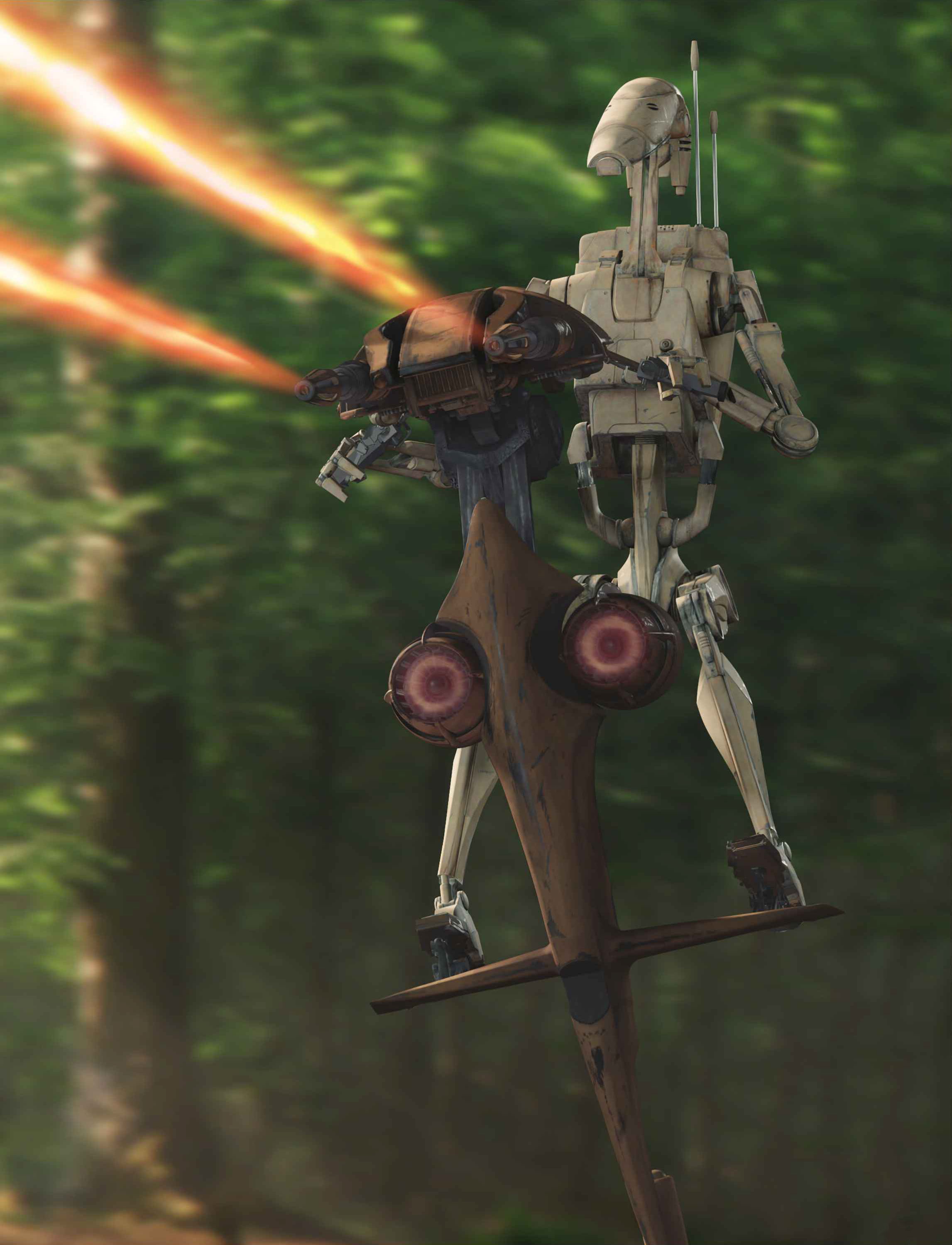
During the Invasion of Naboo, Viceroy Nute Gunray made extensive use of B1 battle droids. Despite their statistical fragility, their overwhelming numbers allowed them to subdue the Naboo and maintain control of the planet's surface. The Trade Federation invasion force that occupied Naboo until the Battle of Naboo primarily consisted of B1s, droidekas, and other mechanized vehicles such as AATs, MTTs, STAPs, and PACs.
Upon their arrival at the Trade Federation blockade of the planet, Jedi Knights Obi-Wan Kenobi and Qui-Gon Jinn pointed out the droids' weaknesses. These technical shortcomings, including slow reaction times, inaccurate weaponry, and simplistic tactics, resulted from the Trade Federation's focus on quantity over quality in B1 production.
The "primitive" Gungan Grand Army and the bulk of the Trade Federation invasion force ultimately clashed in the open during the Battle of Grassy Plains. While the uneven terrain and innovative tactics of the Gungans initially presented a challenge, the overwhelming number of B1s and other machines on the battlefield ultimately proved decisive.
The destruction of the Droid Control Ship by Anakin Skywalker proved to be the turning point and saving grace of the Battle of Naboo. After the Central Control Computer of the droid army was destroyed, all mechanized units on the Grassy Plains reset and became inert, harmless objects.
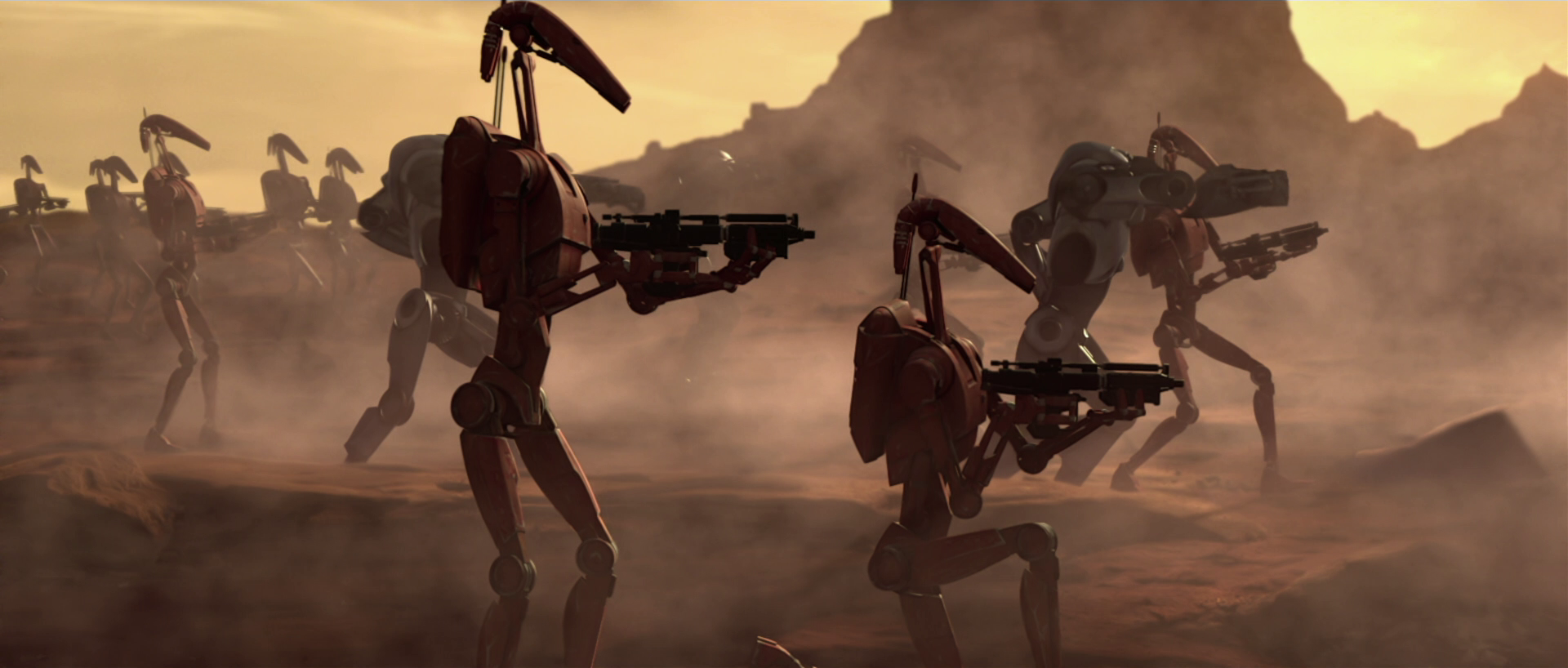
Following the resolution of the Naboo crisis, the Galactic Republic enacted legislation that prohibited the Trade Federation from using droid armies and developing military hardware. However, the Trade Federation relocated its military research and production facilities to territories outside of the Republic's jurisdiction, such as Geonosis.
During this period, the Trade Federation began to recover from the Republic's sanctions and the significant financial losses incurred during the Naboo incident. Existing battle droid models were improved, and new generations of soldiers were developed, including the Super Battle Droid.
The B1s, however, underwent retooling and refitting. Learning from the destruction of the Droid Control Ship above Naboo, the Trade Federation equipped B1s with onboard independent intelligence centers that could operate without a master signal. The spherical centers of the Droid Control Ships were also redesigned to operate on land, which proved to be easier to defend. These newly retrofitted droids were programmed with new tasks, and B1s became warship crewers, pilots, gunners, and emergency responders. However, these tasks pushed the B1s to the limits of their capabilities, and they proved to be rather poor in specialized roles. The entry of the Trade Federation into the Confederacy of Independent Systems did not improve unit quality, as the Neimoidians refused to spend more money on improving their droids and the Techno Union reserved its more powerful cognitive modules for newer, ever-more deadly war droids.
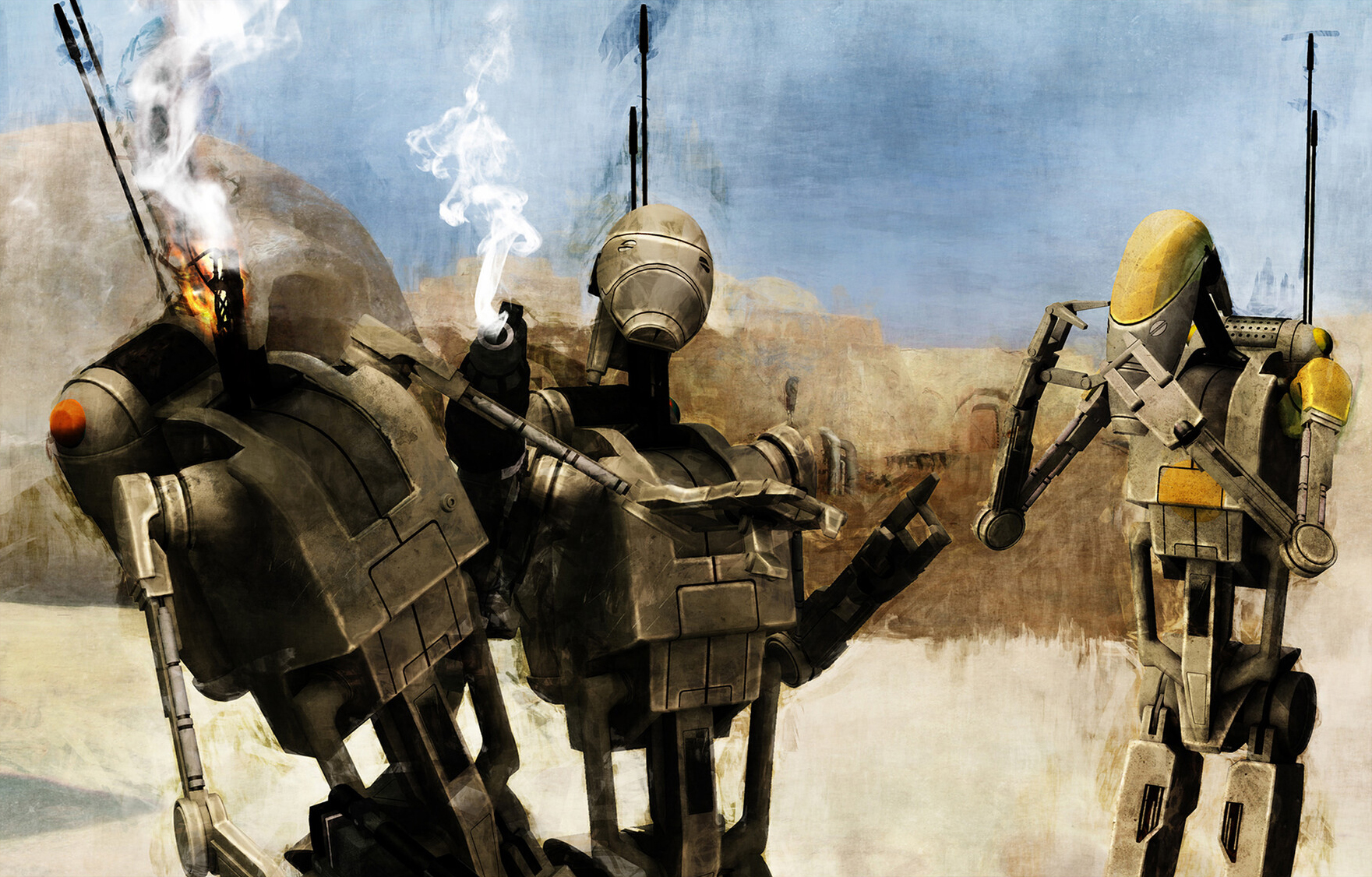
These issues would worsen as the Clone Wars continued. Maintenance became increasingly problematic: diagnostic and memory defragmentation routines tended to erase retrofitted specialty programming, so they were frequently skipped. Cognitive modules gradually suffered data corruption and system errors, leading to shutdowns or behavioral anomalies. To the annoyance of Separatist commanders, B1s became "chatty," offering running commentaries on their situations as their modules struggled to process data overflows.
Following the invasion of Naboo, the Ultragungans kept a large amount of B1 battle droids as spoils of war.
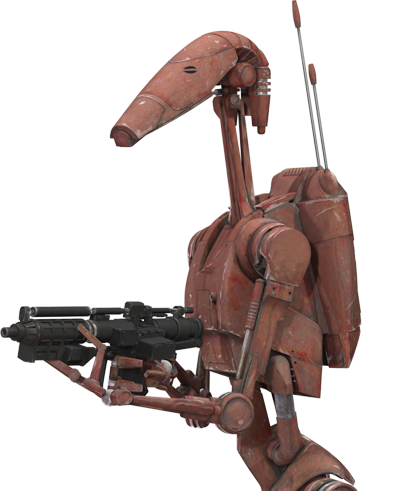
In 22 BBY, Jedi Knight Obi-Wan Kenobi, while tracking Jango Fett to Geonosis, discovered the droid foundry there and contacted the Jedi Council before being convicted for espionage. His apprentice Anakin Skywalker and Padmé Amidala tracked him but were also captured. All three were sentenced to be executed. However, when the three escaped their chains and the arena beasts, and a team of two hundred Jedi arrived, B1s, alongside new B2 super battle droids, entered the arena to stop the Jedi. Many droids were destroyed, but the rest overwhelmed the Jedi through sheer numbers and herded the surviving twenty into the center of the arena. However, clone troopers arrived and rescued the Jedi, and a huge battle ignited outside.
B1s fought clone troopers and Jedi alongside other Separatist droids. However, the clones proved superior, and the battle was won for the Republic. However, many droids escaped the planet aboard Trade Federation core ships, Techno Union Hardcell-class transports, and other ships. The Clone Wars had just begun.
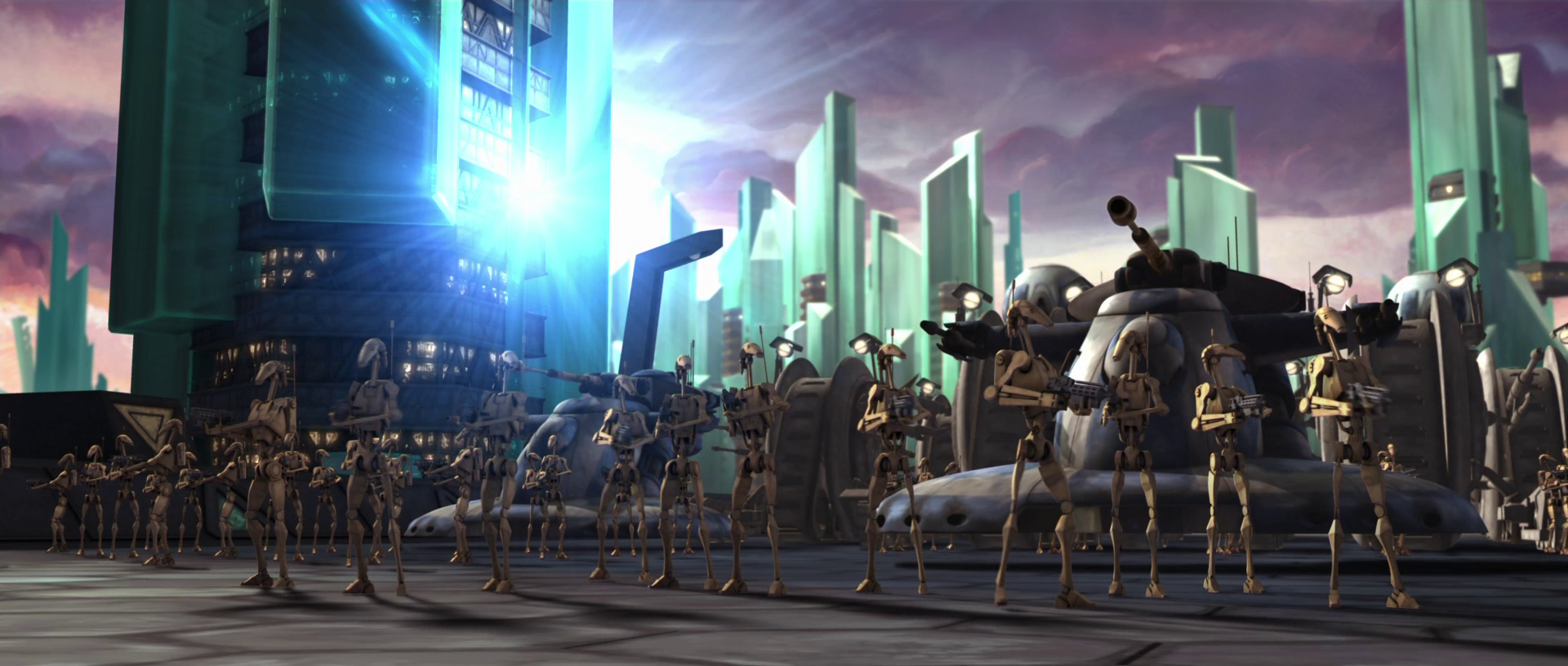
After the Trade Federation joined the Confederacy of Independent Systems, they became a majority of the Separatist Droid Army. B1s would be the Confederacy's most common soldiers, with alleged quintillions churned out on countless CIS factory worlds. Some Confederate commanders such as General Grievous often grew frustrated at the droids, even at times considering them "useless." The battle droids earned the nickname by clone troopers of "clankers."
B1 battle droids would often serve on board starships and battleships. They would man turrets, work computer consoles, drive warships, and serve as security aboard the vessel.
They participated in many battles including, but not limited to, the First Battle of Geonosis, Battle of Muunilinst, Battle of Cato Neimoidia, Battle of Coruscant, and Battle of Kashyyyk.' Despite their notable combat ineffectiveness, B1 Battle Droids did successfully eradicate the Nightsisters clan on Dathomir. Training models were even used on Kamino for the practice tests of Clone cadets.
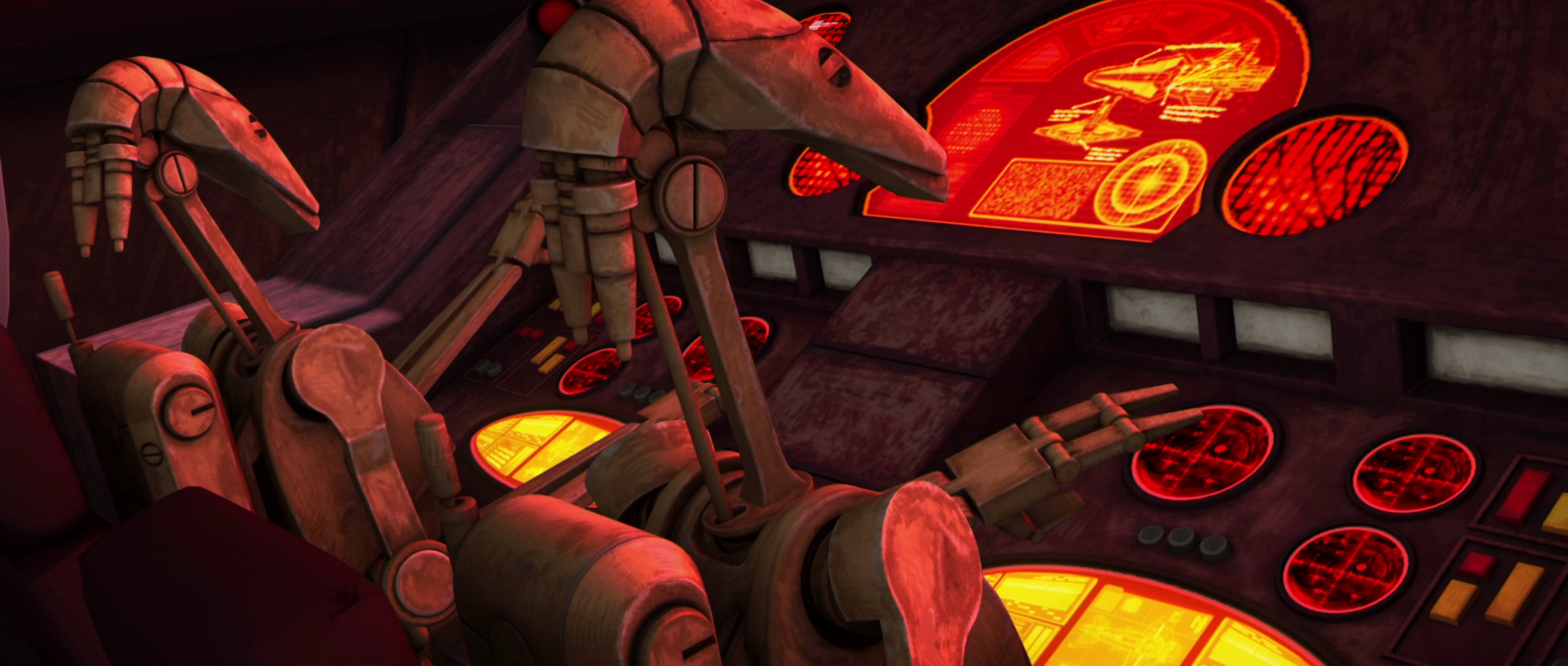
During the Clone Wars, ARC Prudii Skirata spoke to and managed to "convince" an important Separatist metallurgist to give him vital clues on the metallurgic structure of droids. By adding 5% extra carvanium to the droids via the main factory computer at Olanet, these droids crumbled when hit with any weapon. The sabotage acts were so successful that the kill ratio for clone troopers was raised from 20 droids per clone to 50 droids per clone during the first year of the Clone Wars.
The Separatists eventually plotted to replace the B1 with an updated battle droid model, the designs of which were stored on a datachip in an factory. During a Republic raid, a single B1 droid ensured the plans were recovered to Dooku, but the B1 disobeyed his masters by destroying the chip after learning of its purpose, ensuring his B1 brethren would not be reduced to spare parts. Following the execution of the Separatist Council by Darth Sidious's new apprentice, Darth Vader, most, if not all, of the B1s were de-activated. However, some would be re-activated to serve in the various Confederate Remnants, such as the one controlled by Geonosian Gizor Dellso.
Soon after Order 66, surviving Jedi Olee Starstone and Roan Shryne fled to Jaguada, a former Separatist base. Attempting to contact Jedi on Coruscant, they accidentally activated the droid guards. Vader discovered their position and sent troops from the planet to destroy them. The Jedi used the activated droids to serve as a rear-guard against the troopers.
During the rise of the Empire, some B1s were reactivated and reprogrammed for use as security droids. In addition, some were used by Darth Vader to have Falco Sang undergo various intense trials. He initially had the droids armed with stun blasters, although Sang saw through the ruse and ceased either evading the attacks or even shooting back and also attempted escape twice. Upon learning this, Vader ordered the staff to replace the stinger blasters with live blasters, also giving strict orders to have them wound him rather than kill him.
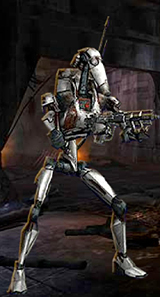
At some point before 12 BBY, Gizor Dellso reactivated a droid army on Mustafar. Shortly after this, the 501st Legion quickly destroyed the army and Dellso in the Battle of Mustafar.
During the Galactic Civil War, B1s left over from the Clone Wars were discovered on Geonosis by Rebel pilot Wedge Antilles after crash landing in his X-wing. Several stormtroopers that had landed on the planet in escape pods managed to destroy many droids by using E-web blasters, but they ultimately fell to the battle droids' overwhelming blaster fire.
Other B1s that weren't deactivated were used in the Death Watch bunker, known crash sites on Tatooine, Separatist holdouts, Stonewall Labs and Borvo's Vault on Naboo, and even on Kashyyyk. Osaji Uhares repaired some and used them as his bodyguards on Centares.
Some of these droids were used by Black Sun pirates in the Death Watch bunker. The Jawa warlord Wittin used one on a Single Trooper Aerial Platform to compete in Jabba Desilijic Tiure's demolition games.
The IG-97 droid bore a close resemblance to the original B1 battle droid, although being developed by Holowan Mechanicals after plans by Phlut Design Systems who had been working for the InterGalactic Banking Clan.
Toy versions of the B1 battle droid were manufactured. Jango Fett's cloned son Boba Fett had some during his youth on Kamino.
The Confederacy's extensive use of B1s contributed to the general distrust of droids in galactic society during the Imperial Period.
B1 battle droids first appeared in 1999 with the release of Star Wars: Episode I The Phantom Menace. Star Wars Episode I: The Visual Dictionary provides a key to color coding in relation to their rank and function, and a table to decipher their numerical digits.
The earliest designs of the battle droid were clearly inspired by the stormtroopers of the original trilogy, suggesting the evolution of large-scale combat in the Star Wars galaxy. The finished droid's proportions are reminiscent of African sculpture. Early design had towering droids twice the height of humans, but subsequent iterations brought their height down to human size.
The "B1" designation originated with the Star Wars Roleplaying Game, to differentiate the battle droid from other models introduced in Star Wars: Episode II Attack of the Clones, and the name was retroactively applied to its earlier appearances. Prior to this, the Roleplaying Game had once identified it as the "Nemoidian Series."
The video games Star Wars Battlefront: Renegade Squadron and Star Wars Battlefront: Elite Squadron feature the labels "Battledroid Mk II" and "Battledroid Mk III" in the personalization editor, though the customization was up to the player.